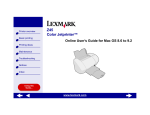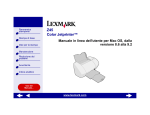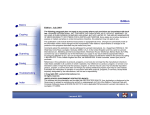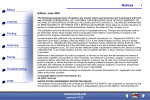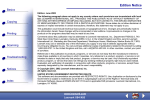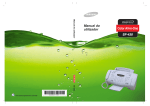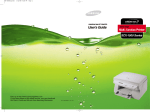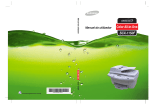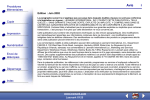Download Compaq IJ1200 Color Inkjet Printer
Transcript
User’s Guide for Windows 95 and Windows 98 First Edition: 2000 The information in this guide is subject to change without notice. COMPAQ COMPUTER CORPORATION SHALL NOT BE LIABLE FOR TECHNICAL OR EDITORIAL ERRORS OR OMISSIONS CONTAINED HEREIN; NOR FOR INCIDENTAL OR CONSEQUENTIAL DAMAGES RESULTING FROM THE FURNISHING, PERFORMANCE, OR USE OF THIS MATERIAL. This guide contains information protected by copyright. No part of this guide may be photocopied or reproduced in any form without prior written consent from Compaq Computer Corporation. Compaq and Presario are registered in the U.S. Patent and Trademark office. Microsoft, MS-DOS, and Windows are registered trademarks of the Microsoft Corporation. © Copyright 2000 Compaq Computer Corporation. All rights reserved. PCL® is a registered trademark of the Hewlett-Packard Company. PCL 3 is Hewlett-Packard Company's designation of a set of printer commands (language) and functions included in its printer products. This printer is intended by Compaq Corporation to be compatible with the PCL 3 language. This means the printer recognizes PCL 3 commands used in various application programs, and that the printer emulates the functions corresponding to the commands. The software described in this guide is furnished under a license agreement or nondisclosure agreement. The software may be used or copied only in accordance with the terms of the agreement. Product names mentioned herein may be trademarks and/or registered trademarks of their respective companies. UNITED STATES GOVERNMENT RESTRICTED RIGHTS This software and documentation are provided with RESTRICTED RIGHTS. Use, duplication or disclosure by the Government is subject to restrictions as set forth in subparagraph (c)(1)(ii) of the Rights in Technical Data and Computer Software clause at DFARS 252.227-7013 and in applicable FAR provisions: Compaq Computer Corporation, Houston, TX 77070. Contents Contents Steps to basic printing 1 Step 1: Load the paper 2 Step 2: Customize the printer settings 5 Step 3: Print your document 8 Printing beyond the basics 9 Printing on both sides of a sheet of paper 9 Printing handouts 12 Printing booklets 15 Printing posters 18 Maintaining your printer 21 Using the Control Program 21 Installing or replacing print cartridges 22 Improving print quality 24 Preserving print cartridges 26 Troubleshooting 27 Printer prints slowly or doesn’t print 27 Paper misfeeds or jams 30 Document prints with mistakes or poor quality 32 Problems with transparencies, photos, or envelopes 34 Error messages and flashing lights 35 • • • • Contents • iii Appendix 37 Installing printer software 37 Uninstalling printer software 38 Printing from DOS 38 Notices 38 Energy star 39 Power supply replacement 39 Safety information 39 Index 41 • • • • iv • Steps to basic printing This book describes how to use your printer with Windows 95 and Windows 98. To view the online User’s Guide for Windows NT 4.0 and Windows 2000, click the User’s Guide button on the Printer Software CD for Windows. Steps to basic printing 1 Basic printing is as easy as: 1 Load the paper (see page 2). 2 Customize the printer settings (see page 5). 3 Print your document (see page 8). Steps to basic printing • •1 • • • Step 1: Load the paper You can load up to 100 sheets of paper (depending on thickness). 1 Place the paper against the right side of the sheet feeder, with the print side facing you. Note: Make sure you do not force the paper into the sheet feeder when you load it. For example, letter or A4 size paper should extend above the top of the paper support Paper support Sheet feeder 2 Squeeze the release tab and the paper guide together and slide the paper guide to the edge of the paper. Release tab • • 2 • Chapter 1 • • Paper guide Loading specialty papers Load up to: Make sure: 10 envelopes • the print side is facing you. • the envelopes are loaded vertically against the right side of the sheet feeder. • the stamp location is in the upper left corner. • the paper guide is against the edge of the envelopes. 10 greeting cards, index cards, postcards, or photo cards • the print side is facing you. 25 sheets of photo paper • the glossy or coated side is facing you. 20 sheets of banner paper • you place the paper behind the printer, and then bring the unattached edge of the first page over the top of the printer, and into the sheet feeder. Steps to basic printing Follow these guidelines when loading specialty papers: • the cards are loaded vertically against the right side of the sheet feeder. • the paper guide is against the edge of the cards. • the paper guide is against the edge of the photo paper. • the paper guide is against the edge of the paper. Note: Make sure you select Banner or Banner A4 paper size in the Printer Properties. Steps to basic printing • • •3 • • Load up to: Make sure: 10 transparencies • the rough sides of the transparencies are facing you (smooth side down). • the paper guide is against the edge of the transparencies. 100 sheets of custom size paper • the print side is facing you. • your paper size fits within these dimensions: - Width: 76 mm to 216 mm 3.0 in. to 8.5 in. - Length: 127 mm to 432 mm 5.0 in. to 17.0 in. • the paper guide is against the side of the paper. 25 iron-on transfers • you follow the instructions on the packaging to load the iron-on transfers. • the paper guide is against the side of the ironon transfers. • • 4 • Chapter 1 • • Step 2: Customize the printer settings The Printer Properties has four tabs: Job Finishing, Paper, Document/Quality, and Advanced. Each tab has settings for operating your printer and its software. Opening the Printer Properties from an application You can open the Printer Properties from almost every application. This lets you change printer settings ONLY for the documents you are currently creating in the application. Steps to basic printing Your printer software includes several applications that let you perform printing tasks. One of these applications is called Printer Properties. 1 Open the application’s File menu. 2 Choose Print (or Printer) Setup. 3 In the Printer Setup dialog box, click the Properties, Option, or Setup button (depending on the application). Opening the Printer Properties from Windows When you open the Printer Properties from Windows, the settings apply to ALL documents, unless you change them from the application. 1 From the Start menu, select Settings, and then select Printers. 2 From the Printers folder, right-click the printer icon for your printer. 3 Select Properties from the sidebar menu. Steps to basic printing • • •5 • • Click the... Paper tab to: Document/Quality tab to select: • Select a paper size and orientation • Set the number of copies to print • Reverse the printing order of your document pages. The first page of your document will be on top of the stack in the paper exit tray. • Collate your document • Color settings for the type of document you are printing • The type of paper you are using • A print quality setting • Web Smoothing when you print from the internet • Allow Pages to Dry • The default settings Job Finishing tab to print: Advanced tab to adjust: • • • • • Halftone settings • Image settings Handouts Posters Booklets Two-sided documents Help button on any tab in the Printer Properties to access the printer driver Help. • • 6 • Chapter 1 • • When your printer software was installed, the Printer Properties settings were set to the default settings. Use the default settings for printing most documents on plain paper. To change your printer settings for printing on specialty papers, use the following table. When you are printing on: Click this Printer Properties tab: Envelopes Paper To make these selections: From the Paper Size area, scroll to select the appropriate envelope size. Steps to basic printing Customizing printer settings for specialty papers Note: Your application may override the envelope settings in Printer Properties. Greeting cards, index cards, postcards, or photo cards Paper Select the appropriate Paper Size setting. Document/Quality From the Paper Type area, select Greeting Card Stock. Photo papers, glossy or coated papers Document/Quality From the Paper Type area, select Glossy/Photo Paper. Notes: • You can print quality photos with the black and color cartridge combination that came with your printer. However, for the best possible print quality, replace the black cartridge with a photo cartridge, part number 12A1990. For help, see page 22. • When printing photos, remove each photo as it exits from the printer and allow it to dry before stacking. Banner paper Paper From the list of Paper Sizes, select Banner or Banner A4. Steps to basic printing • • •7 • • When you are printing on: Sheets of custom size paper Click this Printer Properties tab: Paper To make these selections: • From the list of Paper Sizes, scroll to select Custom. • Enter the dimensions for your custom paper size. For help, see page 4. Iron-on transfers Document/Quality From the Paper Type area, select Iron-On Transfer. Note: Many software applications accept iron-on transfers differently. We recommend printing your document on plain paper before printing it on an iron-on transfer. Transparencies Document/Quality • From the Paper Type area, select Transparency. • Select Normal (600 x 600 dpi), High (1200 x 1200 dpi), or Maximum (2400 x 1200 dpi) Print Quality. Note: When printing transparencies, remove each transparency as it exits from the printer and allow it to dry before stacking. Step 3: Print your document 1 From your application’s File menu, click Print. 2 From the Print dialog box, click OK or Print (depending on the application). • • 8 • Chapter 1 • • 2 Printing beyond the basics • on both sides of a sheet of paper (see the following section) • handouts (see page 12) • booklets (see page 15) • posters (see page 18) Printing on both sides of a sheet of paper Your Compaq printer lets you print on both sides of a sheet of paper. Besides saving paper, this feature is helpful when you want to print booklets or tablets. Printing beyond the basics You can use your printer to print: Step 1: Load the paper Load up to 100 sheets of paper against the right side of the sheet feeder and slide the paper guide to the edge of the paper. For help, see page 2. Printing beyond the basics • •9 • • • Step 2: Customize the printer settings for your two-sided print job 1 Open the Printer Properties. For help, see page 5. 2 Select the page orientation and size: a Click the Paper tab. b Select the appropriate Paper Size. c Select Portrait or Landscape orientation. 3 Customize the Printer Properties for two-sided printing: a Click the Job Finishing tab. b Select Two-sided printing. c Select a binding edge. When you select Portrait orientation, choose between these binding edge options. d To receive paper reloading instructions, select Print reloading instructions after the first side prints. e Click OK. Note: When you select Landscape orientation, choose between these binding edge options: Long Edge Short Edge Binding Binding • • 10 • Chapter 2 • • Step 3: Print your two-sided document a When the entire stack is finished printing, remove the stack. b Flip the stack of paper. c Insert the stack of paper and instruction page with the printed side facing away from you and the arrows pointing down. Printing beyond the basics 1 From your application’s File menu, select Print. The odd-numbered pages print first. 2 When the odd-numbered pages of your two-sided document are finished printing, your printer software prompts you to reload the paper. Note: The direction of the arrows on your instruction page may be different than the instruction page shown. Always insert the stack of paper and instruction page with the arrows pointing down. 3 Click OK. The even-numbered pages print on the other side. 4 To return to single-sided printing: a From the Job Finishing tab, make sure Two-sided printing is not selected. b Click OK. Printing beyond the basics • • • 11 • • Printing handouts You can conserve paper by printing handouts or multiple page images on a single sheet of paper. Four page images on a single sheet of paper Step 1: Load the paper Load up to 100 sheets of paper against the right side of the sheet feeder and slide the paper guide to the edge of the paper. For help, see page 2. Step 2: Customize the printer settings for your handouts You can print your handouts on one side of the paper, or on both sides of the paper. 1 Open the Printer Properties. For help, see page 5. 2 Select the page orientation for the page images: Note: The page orientation you select in the Paper tab reflects the orientation of the page image and not the sheet of paper the page image prints on. a Click the Paper tab. b From the Orientation area, select Portrait or Landscape. 3 From the Paper Size area, select a paper size. • • 12 • Chapter 2 • • 4 Customize the settings in Printer Properties for printing handouts. b Select Handout. c Select the Number of Prints (page images) to print on a single sheet. The graphic shows three Portraitoriented page images with Page Borders. d To print a border representing the paper edges for each page image, select Print Page Borders. a Click the Job Finishing tab. Printing beyond the basics Note: The screen graphic changes as you make selections, showing how the printed page will look. 5 To print your handout on one side of the paper, click OK. To print your handout on both sides of the paper: a Select Two-sided printing. b To receive paper reloading instructions, select Print reloading instructions after the first side prints. c Click Long Edge Binding or Short Edge Binding. d Click OK. Printing beyond the basics • • • 13 • • Step 3: Print your handouts 1 From your application’s File menu, select Print. 2 From the Print dialog box, click OK or Print (depending on the application). • If you formatted your handouts to print on one side of each page, go to step 5. • If you formatted your handouts for two-sided printing, continue with printing the second side of your handouts. 3 When the first side of all your handouts is finished printing, your printer software prompts you to reload the paper. a When the entire stack is finished printing, remove the stack. b Flip the stack of paper. c Insert the stack of paper and instruction page with the printed side facing away from you and the arrows pointing down. Note: The direction of the arrows on your instruction page may be different than the instruction page shown. Always insert the stack of paper and instruction page with the arrows pointing down. 4 Click OK. The second side of all your handouts prints on the other side. 5 To return to normal printing: a From the Job Finishing tab, select Normal. b Click OK. • • 14 • Chapter 2 • • Printing booklets You can print and bundle your document together to make a booklet. Load up to 100 sheets of paper against the right side of the sheet feeder and slide the paper guide to the edge of the paper. For help, see page 2. Step 2: Customize the printer settings for your booklet 1 Select the correct settings in your software application: a Select Portrait page orientation. b Select from these paper sizes: • Statement • Letter • A4 • A5 2 Open the Printer Properties. For help, see page 5. 3 Click the Job Finishing tab. 4 Select Booklet. 5 Select the number of Sheets Per Bundle. Notes: • A bundle is any number of sheets of paper folded together. For help, see page 17. • When printing with a heavier paper stock, select a smaller number of Sheets Per Bundle to allow for binding considerations. 6 To receive paper reloading instructions, click Print reloading instructions after the first side prints. 7 Click OK. Printing beyond the basics Printing beyond the basics Step 1: Load the paper • • • 15 • • Step 3: Print your booklet 1 From your application’s File menu, select Print. 2 From the Print dialog box, click OK or Print (depending on the application). 3 When the first side of your booklet is finished printing, your printer software prompts you to reload the paper. a When the entire stack is finished printing, remove the stack. b Flip the stack of paper. c Insert the stack of paper and instruction page with the printed side facing away from you and the arrows pointing down. Note: The direction of the arrows on your instruction page may be different than the instruction page shown. Always insert the stack of paper and instruction page with the arrows pointing down. 4 Click OK. The second side of your booklet prints on the other side. 5 To return to normal printing: a From the Job Finishing tab, select Normal. b Click OK. 6 Assemble your booklet. For help, see page 17. • • 16 • Chapter 2 • • Step 4: Build your booklet Once your document prints, stack the bundles together and bind your booklet. Printing beyond the basics Printing beyond the basics 1 Take the first bundle from the paper exit tray, fold it in half, and set it aside. 2 Take the next bundle, fold it in half, and stack it on top of Five bundles the first bundle. stacked to form a booklet. 3 Stack the rest of your bundles, one on top of the other, until your booklet is complete. 4 Bind the bundles together to complete your booklet. • • • 17 • • Printing posters The poster finishing option is designed to print a single-page as a 4, 9, or 16-page poster. For example, you can enlarge a photograph to poster size. A single page enlarged to a nine page poster. Step 1: Load the paper Load up to 100 sheets of paper against the right side of the sheet feeder and slide the paper guide next to the paper. For help, see page 2. Note: For the best print quality, use a heavy-weight paper. Step 2: Customize the printer settings for your poster 1 2 3 4 Open the Printer Properties. For help, see page 5. Click the Job Finishing tab. Select Poster. Select your poster size. The number you select represents the number of pages that make up the height and width of your poster. For example, if you select 4 x 4, your printed poster is four pages high and four pages wide. 5 Select Show Crop Marks if you want to print markers that show you where to easily trim (crop) the unprinted white Crop marks space from the edges of the paper. make it easy to trim the poster 6 Click OK. pages. • • 18 • Chapter 2 • • Step 3: Print and assemble your poster Note: If you need to reprint a specific page(s) of your poster, see page 20. 3 On each printed page, trim the white edges from two adjacent sides. For example, trim the white edge from the top and left sides of each page. Printed pages with the white edge trimmed from two adjacent sides Trimmed edges Printing beyond the basics 1 From your application’s File menu, select Print. 2 From the Print dialog box, click OK or Print (depending on your software application.) Untrimmed edges 4 Arrange the pages so that every trimmed edge overlaps an untrimmed edge (the white edge). 5 Tape the back of the pages together. 6 To complete your poster, trim any remaining white edges. Printing beyond the basics • • • 19 • • Selecting specific pages to print You can reprint specific pages of your poster without having to reprint all of the pages of your poster. To select specific pages to print: 1 From the Job Finishing tab, click Select Pages to Print. 2 From the Select Pages to Print screen, do one of the following: Click Select All to select all the tiles, and then click the tiles you do not want to print. or To quickly select a few tiles to print, click Remove All to remove all the tiles, and then click the tiles you want to print. Note: In the example shown, only one page (tile 1) is selected to print. 3 4 5 6 • • 20 • Chapter 2 • • Click OK. Print your poster page(s). Assemble your poster. For help, see page 19. To return to regular printing: a From the Job Finishing tab, select Normal. b Click OK. 3 Maintaining your printer The Control Program lets you monitor your printer and install or replace print cartridges. To open the Control Program, double-click the Compaq IJ1200 printer icon on your desktop or from the Start menu, click: 1 Programs. 2 Compaq IJ1200. 3 Compaq IJ1200 Control Program. Click the... Cartridges tab to: Options tab to enable/disable various printer software functions, such as Sound Effects and Buffer Mode. Status tab to: • Monitor the status of your print job. • Cancel your print job. • Print a test page. • • • • • Maintaining your printer Using the Control Program View your ink levels. Install or replace print cartridges. Align print cartridges for best print quality. Clean the print nozzles. View cartridge part numbers and order supplies directly from Compaq’s Web site. About tab to find printer software version and copyright information. DOS Printing tab to change settings for DOS printing. DOS printing is only available when your printer is connected with a parallel cable. Help button on any tab in the Control Program to access the printer driver Help. Maintaining your printer • • 21 • • • Installing or replacing print cartridges 1 Make sure the Power light is On. Power light On Paper Feed light Off 2 Raise the front cover. The print cartridge carrier moves to the loading position unless the printer is busy. Front cover Print cartridge carrier in the loading position 3 Remove the old print cartridge. Store it in an air-tight container or dispose of it. • • 22 • Chapter 3 • • 4 Install the replacement cartridge in the printer: If you are installing a new cartridge, remove only the sticker and transparent tape on the bottom of the print cartridge. Push back firmly on the cartridge until it snaps securely into place. 5 Close the front cover. 6 From the Control Program’s Cartridges tab, select Install/Change Cartridge. For help, see page 21. 7 Select the cartridge type you installed and click OK. Standard Color p/n 15M0120 Maintaining your printer Warning: DO NOT touch the gold area on the print cartridge. Insert the replacement print cartridge into the print cartridge carriage. Standard Black p/n 12A1970 High Yield Color p/n 15M0125 High Yield Black p/n 12A1975 Photo p/n 12A1990 8 If you installed a new cartridge, the Alignment dialog box displays. Follow the instructions on the Alignment screen to complete the cartridge installation. For help, see page 24. Maintaining your printer • • • 23 • • Improving print quality If the print quality is not satisfactory, you may need to align your cartridges or clean the print nozzles. Aligning print cartridges 1 Load plain paper in the printer. 2 From the Control Program’s Cartridges tab, select Align Cartridges. For help, see page 21. Your printer prints an alignment test page and the Align Cartridge dialog box displays. The test page that prints has several alignment patterns, depending on the cartridge combination installed. Each pattern has a number under it. The test page that prints is similar to the one shown: In this example, in alignment group A, 16 comes closest to forming a straight line. 3 From each alignment group on the test page, find the number under the alignment pattern that comes closest to forming a straight line. 4 In the Align Cartridges dialog box, enter the pattern numbers from the printed test page that come closest to forming a straight line. • • 24 • Chapter 3 • • 5 After you have entered a number for all of the patterns, click OK. Cleaning print nozzles Cyan, magenta, yellow, and black purge lines (shown here in black and white) print when ink is forced through the print nozzles. If any of these colors do not print, you may need to replace your print cartridge. Broken lines at the top of the page indicate clogged nozzles. Unbroken lines at the bottom of the page indicate the nozzles were cleaned. Maintaining your printer 1 Load plain paper in the printer. 2 From the Control Program’s Cartridges tab, select Clean Print Nozzles. For help, see page 21. The printer feeds a sheet of paper and prints a nozzle test pattern, similar to the one shown: 3 Compare the diagonal lines above the printed bars to the diagonal lines below the printed bars. Look for a break in the diagonal lines above the printed bars. Broken lines indicate clogged nozzles. • If the bottom lines have breaks, run the test up to two more times. If the print quality is satisfactory after running the test three times, the print nozzles are clean. • If the print quality of both lines is still not satisfactory, wipe the print cartridge nozzles. For help, see the next section. Maintaining your printer • • • 25 • • Wiping print nozzles If print quality does not improve after cleaning the print nozzles (see page 25), you may need to wipe the print nozzles. Refer to the “Troubleshooting: Print Quality” section of the printer driver Help. For help accessing the printer driver Help, see page 6. Preserving print cartridges To ensure the longest life from your print cartridge and optimum performance from your printer: • Keep a new print cartridge in its packaging until you are ready to install it. • Do not remove a print cartridge from the printer except to replace, clean, or store it in an air-tight container. The print cartridge does not print correctly if removed from the printer and left exposed for an extended period of time. • If a print cartridge runs out of ink, leave the empty cartridge in the printer until you are ready to replace it. Printing with only one of the print cartridges in the printer may cause printer problems. Compaq’s printer warranty does not cover repair of failures or damage caused by a refilled cartridge. Compaq does not recommend use of refilled cartridges. Refilling cartridges can affect print quality and cause damage to the printer. For best results, use Compaq recommended supplies. • • 26 • Chapter 3 • • 4 Troubleshooting From the list of printing problems in the left margin, select a category that describes your printing problem, and then read the category for the solution. Paper misfeeds or jams (see page 30) • The power supply is plugged into the printer and a properly grounded electrical outlet. Document prints with mistakes or poor quality (see page 32) • The printer cable is securely attached to your computer and printer. Problems with transparencies, photos, or envelopes (see page 34) Error messages and flashing lights (see page 35) When your printer has a problem, first make sure that: • The printer is turned On. • If you are using a parallel cable, it is an IEEE 1284compliant parallel cable that supports bidirectional printing. Troubleshooting Printer prints slowly or doesn’t print (see next section) • Bidirectional (two-way) communications is enabled in your printer software. 1 From the printer’s Control Program, click the Options tab. 2 Make sure Disable Printer to PC Communications is not selected. Printer prints slowly or doesn’t print Your printer and your computer may not be able to communicate properly. The following events also indicate two-way communications problems: • A message displays on your computer screen indicating your printer cannot establish bidirectional communications with your computer. Troubleshooting • • 27 • • • • Print cartridge ink level indicators on the Status or Cartridges tabs of the printer’s Control Program are shaded. • Error messages (such as Printer Offline) and job progress information do not display on your computer screen. Before proceeding, verify that: • The printer software is installed correctly. For help, see page 37. • The parallel or USB cable is securely attached to both the printer and the personal computer. • The printer is plugged in and turned On. • Your printer port is set to an LPTn port if you are using a parallel cable or to a USB port if you are using a USB cable. For help, see page 28. • If you are using Windows 98 or Windows 2000, your printer port is set to an LPTn port for a parallel cable, or to a USB port for a USB cable. To check your printer port and change it if necessary: 1 From the File menu of your software application, select Print (or Printer) Setup. 2 Check your printer port in the Where area. 3 If you need to change your printer port, uninstall and then reinstall the printer software following the instructions on page 38. • If you have a switch box or other device (such as a scanner or fax) connected to the computer's parallel port, it supports bidirectional communication. You may need to disconnect your printer from the switch box or other device and connect it directly to your computer. • • 28 • Chapter 4 • • Printer ejects a blank page after appearing to print Make sure: • You have removed the sticker and transparent tape on the bottom of the print cartridges. For help, see page 22. • Your Compaq printer is set as the default printer. Make sure: • The printer is turned On, and the paper is loaded correctly. • The parallel or USB cable is completely plugged into the printer. • Your Compaq printer is set as the default printer. Troubleshooting Printer is plugged in but doesn’t print, or you get a Printer Offline message • The printer is not being held or paused. To check the printer status: 1 From the Printers folder, double-click the Compaq IJ1200 icon. 2 Click the Printer menu and make sure no check mark appears next to the Pause Printing option. • If you have a switch box or other device (such as a scanner or fax) connected to the computer's parallel port, it supports bidirectional communication. You may need to disconnect your printer from the switch box or other device and connect it directly to your computer. Print a test page. If the test page prints, the printer is functioning properly. Check your software application. Troubleshooting • • • 29 • • Test page does not print Make sure: • Your print cartridges are properly installed. For help, see page 22. • You are using the correct cable, and it is not damaged. If you are using a parallel cable, make sure it is an IEEE 1284compliant parallel cable that supports bidirectional printing. • Your Compaq printer is set as the default printer. Printer prints very slowly • Close any open applications not in use. • Select Normal (600 x 600 dpi) or Draft (300 x 600 dpi) on the Document/Quality tab of Printer Properties. For help, see page 5. • Consider purchasing more memory or increasing the virtual memory for your computer. Note: Photos or documents containing graphics may take longer to print than regular text. Paper misfeeds or jams Printer does not feed envelopes If regular paper feeds without problems, make sure: • You are loading the envelopes correctly. For help, see page 3. • You are using an envelope size supported by your printer, and it is selected in Printer Properties. • Your application is designed to print envelopes. Check the user’s documentation that came with your application. • • 30 • Chapter 4 • • Paper misfeeds or multiple sheets feed Make sure: • The paper guide is against the side of the paper and it does not cause the paper to bow in the sheet feeder. • You are using a paper recommended for inkjet printers. • You do not force the paper down into the printer when you load it. • You do not load too much paper in the sheet feeder. Depending on the thickness of your paper, the sheet feeder can hold up to 100 sheets of paper. • The printer is on a flat, level surface. Printer has a paper jam Troubleshooting • The top edge of the paper extends above the top of the paper support if you are loading letter or A4 size paper. Remove the paper from the sheet feeder. If the paper is lodged too far into the printer and can’t be removed: 1 Press the Power button to turn the printer Off. 2 Pull firmly on the paper to remove it. If you cannot reach the paper because it is too far into the printer, raise the front cover and pull the paper out. 3 Close the front cover. 4 Press the Power button to turn the printer On. 5 Resend your document to print. Troubleshooting • • • 31 • • Document prints with mistakes or poor quality Vertical straight lines are not smooth To improve the print quality of vertical straight lines in tables, borders, and graphs: • Select High (1200 x 1200 dpi) or Maximum (2400 x 1200 dpi) Print Quality from the Document/Quality tab of Printer Properties. For help, see page 5. • Test the cartridge alignment. For help, see page 24. • Clean the print nozzles. For help, see page 25. Characters are missing or unexpected • Make sure your Compaq printer is selected as the default printer. • Your printer may have two-way communication problems. For help, see page 27. Print is too dark or smudged Make sure: • You let the ink dry before handling the paper. • The Paper Type setting in the Printer Properties matches the paper type loaded in the printer. • The paper is straight and unwrinkled. • The Print Quality setting is appropriate for the paper type. If you are printing on regular paper, select the Draft (300 x 600 dpi) Print Quality setting from the Document/Quality tab of Printer Properties. For help, see page 5. • The print nozzles are clean. For help, see page 25. • • 32 • Chapter 4 • • Printed pages have alternating bands of light and dark print (intermittent printing) • Make sure Enable Buffer Mode is selected on the Options tab of the Control Program. For help, see page 21. • Select High (1200 x 1200 dpi) or Maximum (2400 x 1200 dpi) Print Quality on the Document/Quality tab of Printer Properties. For help, see page 5. Print quality is poor at the left, right, top or bottom edge of page Your printer cannot print in the extreme left, right, top or bottom edges of a page. Use these minimum settings: Troubleshooting • Your printer may have two-way communications problems. For help, see page 27. • Left and right margins: 6.35 mm (0.25 in.) each for all paper sizes except A4 For A4 size paper - 3.37 mm (0.133 in.) each • Top and bottom margins: Top - 1.7 mm (0.067 in.) Bottom - 16.51 mm (0.65 in.) Colors on the printout are faded or differ from the colors on the screen • An ink cartridge may be out of ink or low on ink. Check the ink level graphic on the Cartridges tab of your printer’s Control Program. For help, see page 21. • From the Document/Quality tab of Printer Properties, select Natural Color as the Document Type. For help, see page 5. Troubleshooting • • • 33 • • • Use a different brand of paper. Every paper brand accepts ink differently and prints with slight color variations. • Clean the print nozzles. For help, see page 25. • If the colors still seem faded, wipe the print nozzles. For help, see the “Troubleshooting: Print Quality” section of your printer driver Help. For help accessing the printer driver Help, see page 6. Problems with transparencies, photos, or envelopes Transparencies or glossy photo papers stick together • Remove each page as it exits the printer and allow to dry completely before stacking. • Use a transparency or photo paper designed for an inkjet printer. Transparencies or photos contain white lines • From the Printer Properties, select High (1200 x 1200 dpi) or Maximum (2400 x 1200 dpi) Print Quality. For help, see page 5. • Your print nozzles may need cleaning. For help, see page 25. Printer does not feed envelopes For help, see page 32. • • 34 • Chapter 4 • • Error messages and flashing lights Paper Jam message For help, see page 32. Power Paper light Feed light Ink Low message The Power light is On and the Paper Feed light is blinking • If the printer is out of paper: 1 Load paper. 2 Press the Paper Feed button. Power button Troubleshooting The print cartridge is running out of ink. Purchase a new print cartridge. For help replacing your print cartridge, see page 22. Paper Feed button • If the printer has a paper jam, see page 32 for help. The Power light blinks twice The print cartridge carrier has stalled. Check your screen for any error messages. 1 Turn the printer Off. 2 Wait a few seconds, and then turn the printer back On. Troubleshooting • • • 35 • • • • 36 • Chapter 4 • • Appendix In this section, you can find information about: Installing printer software Uninstalling printer software Printing from DOS Notices Safety Installing printer software You can obtain the printer software using: • the compact disc (CD-ROM) that came with your printer • the World Wide Web • diskettes If your printer software does not install properly, a communications error message appears when you try to print. You may need to uninstall, and then reinstall the printer software. For help, see page 38. Using the CD-ROM To install the printer software: Note: If the CD does not run automatically when you insert it: 1 From the Start menu, select Run. 2 In the command-line text box, type the letter of your CD-ROM drive, followed by :\setup (for example, d:\setup), and then click OK. Using the World Wide Web If your computer does not have a CD-ROM drive, you can download the printer software from the World Wide Web at www.compaq.com. 1 From Compaq’s Web site, select the appropriate driver for your operating system. 2 Select Save to Disk. 3 Select a location on your hard disk drive. Compaq dealer that has a CD-ROM drive. You will need at least three blank 3.5 inch diskettes. To create diskettes of the printer software: 1 Insert the software CD into the CD-ROM drive. If the CD does not run automatically: a From the Start menu, select Run. b In the command-line text box, type the letter of your CD-ROM drive, followed by :\setup (for example, d:\setup), and then click OK. 2 When the Compaq IJ1200 software installation screen appears, select Tools. 3 Select Create Diskettes. 4 Follow the instructions on the screen. To install the printer software from diskettes: 1 Start Windows. 4 Double-click the executable (.exe) file to open it. 2 Click Cancel on any screens that appear. 5 Follow the instructions on your screen. 2 Insert Setup Disk 1 into your disk drive. 3 When the desktop appears, insert the software CD. Using diskettes 3 From the Start menu, select Run. The Compaq IJ1200 software installation screen appears. Appendix • • • • • 4 Click Install Printer Software. 1 Start Windows. If your computer does not have a CD-ROM drive, you can create driver diskettes using a friend’s computer or a computer at your Appendix • • • 37 • • 4 In the command-line text box, type the letter of your disk drive, followed by :\setup (for example, a:\setup), and then click OK. 5 When prompted by the printer software, insert the appropriate disks into your disk drive and click OK. 6 Follow the instructions on the screen. Ordering Diskettes If your computer does not have a CD-ROM drive, and you do not have access to either the World Wide Web or a computer with a CD-ROM drive, you can order diskettes from our Technical Support Center. Uninstalling printer software If your printer software does not install properly, or your printer port is not set to the correct port, you may need to uninstall, and then reinstall your printer software. To uninstall the printer software: 1 From the Start menu, select Programs. 2 Select Compaq IJ1200. 3 Select Compaq IJ1200 Uninstall. 4 Follow the instructions on your screen. To reinstall the printer software following the instructions from “Installing printer software” on page 37. Printing from DOS DOS printing is only available when your printer is connected to your personal computer with a parallel cable. To open your printer online Help system and find information on printing from DOS: 1 Open the Printer Properties (for help, see page 5) or the Control Program (for help, see page 21). 2 Click the Help button in the lower-right corner of the software screen. 3 At the top of the Help screen, click Help Contents. 4 Scroll down the screen to How to.... 5 From the How to... topics, click Print from Windows and DOS applications. Notices Federal Communications Commission (FCC) Compliance Information Statement This equipment has been tested and found to comply with the limits for a Class B digital device, pursuant to Part 15 of the FCC Rules. Operation is subject to the following two conditions: (1) this device may not cause harmful interference, and (2) this device must accept any interference received, including interference that may cause undesired operation. The FCC Class B limits are designed to provide reasonable protection against harmful 38 • • • • • Appendix interference in a residential installation. This equipment generates, uses and can radiate radio frequency energy and, if not installed and used in accordance with the instructions, may cause harmful interference to radio communications. However, there is no guarantee that interference will not occur in a particular installation. If this equipment does cause harmful interference to radio or television reception, which can be determined by turning the equipment off and on, the user is encouraged to try to correct the interference by one or more of the following measures: • Reorient or relocate the receiving antenna. • Increase the separation between the equipment and receiver. • Connect the equipment into an outlet on a circuit different from that to which the receiver is connected. • Consult your point of purchase or service representative for additional suggestions. The manufacturer is not responsible for any radio or television interference caused by using other than recommended cables or by unauthorized changes or modifications to this equipment. Unauthorized changes or modifications could void the user's authority to operate this equipment. To assure compliance with FCC regulations on electromagnetic interference for a Class B computing device, use a properly shielded and grounded cable. Use of a substitute cable not properly shielded and grounded may result in a violation of FCC regulations. Any questions regarding this compliance information statement should be directed to: Compaq Computer Corporation P. O. Box 692000, Mail Stop 510101 Houston, Texas 77269-2000 Or, call (281) 514-3333 Industry Canada Compliance Statement Avis de conformité aux normes d’Industrie Canada Cet appareil numérique de la classe B respecte toutes les exigences du Règlement sur le matériel brouilleur du Canada. European Community (EC) Directives Conformity This product is in conformity with the protection requirements of EC Council directives 89/336/EEC and 73/23/EEC on the approximation and harmonization of the laws of the Member States relating to electromagnetic compatibility and safety of electrical equipment designed for use within certain voltage limits. As an Energy Star Partner, Compaq Computer Corporation has determined that this product meets the Energy Star guidelines for energy efficiency. This product satisfies the Class B limits of EN 55022 and safety requirements of EN 60950. Power supply replacement Japanese VCCI Notice The United Kingdom Telecommunications Act 1984 This apparatus is approved under the approval number NS/G/1234/J/100003 for the indirect connections to the public telecommunications systems in the United Kingdom. Energy star The EPA ENERGY STAR Computers program is a partnership effort with computer manufacturers to promote the introduction of energy-efficient products and to reduce air pollution caused by power generation. Companies participating in this program introduce personal computers, printers, monitors, or fax machines that power down when they are not being used. This feature will cut the energy used by up to 50 percent. Compaq is proud to be a participant in this program. If your power supply fails, replace it with the Compaq replacement part or other UL LISTED Direct Plug-In Power Unit marked “Class 2" and rated 30 V dc at 500 mA. Safety information • If your product is NOT marked with this symbol , it MUST be connected to an electrical outlet that is properly grounded. • The power supply must be connected to an electrical outlet that is near the product and easily accessible. • Refer service or repairs, other than those described in the operating instructions, to a professional service person. • This product is designed, tested and approved to meet strict global safety standards with the use of specific authorized components. The safety features of some parts may not always be obvious. The printer manufacturer is not responsible for the use of other replacement parts. Appendix Appendix This Class B digital apparatus meets all requirements of the Canadian Interference-Causing Equipment Regulations. A declaration of conformity with the requirements of the Directive has been signed by the assigned parties within Compaq Computer Corporation. • • •39 • • 40 • • • • • Appendix Index A aligning print cartridges 24 B C cards loading 3 setting recommenda- D default settings 7 diskettes, installing printer software 37 DOS printing 38 downloaded printer driver installing 37 duplexing 9 E Energy Star 39 envelopes loading 3 problems 30 setting recommendations 7 error messages Ink Low 35 Paper Jam 31, 35 Printer Offline 29 European Community Directives Conformity 39 Index banding 33 banners loading 3 setting recommendations 7 bidirectional communications disabling 27 problems 27 binding options long edge 10 selecting 13 short edge 10 blinking lights Paper Feed 35 Power 35 booklets building 17 bundling 17 printing 15 buttons Paper Feed 35 Power 35 tions 7 cartridges, print aligning 24 installing 22 part numbers 21 preserving 26 removing 22 replacing 22 CD-ROM installing software 37 characters, missing or unexpected 32 coated paper setting recommendations 7 Control Program using 21 crop marks, selecting 18 custom size paper loading 4 setting recommendations 8 F Federal Communications Commission (FCC) Compliance Information Statement 38 flashing lights troubleshooting 35 foils See transparencies G glossy paper setting recommendations 7 greeting cards loading 3 setting recommendations 7 Index • • • • • 41 H halftone settings adjusting 6 handouts printing 14 setting recommendations 12 I image settings adjusting 6 improving print quality 24 index cards loading 3 setting recommendations 7 Industry Canada Compliance Statement 39 Ink Low message 35 installing print cartridge 22 printer software 37 intermittent printing 33 Internet printing Web Smoothing 6 iron-on transfers loading 4 setting recommendations 8 • • • • M margins minimum settings 33 messages, error Ink Low 35 Paper Jam 35 Printer Offline 29 N Japanese VCCI Notice 39 notices Energy Star 39 European Community Directives Conformity 39 Federal Communications Commission (FCC) Compliance Information Statement 38 Industry Canada Compliance Statement 39 Japanese VCCI Notice 39 nozzles, print cleaning 25 wiping 26 n-up printing See handouts L O lights Paper Feed 35 patterns 35 Power 22 ordering supplies 21 J 42 • loading paper 2 specialty papers 3 long edge binding 10 P paper jams 31 loading 2 Paper Feed button 35 Paper Feed light 35 paper guide locating 2 using 2 parallel cable connection problems 27 specifications 27 part numbers black cartridge 23 color cartridge 23 photo cartridge 7, 23 print cartridges 21 photo cards loading 3 setting recommendations 7 photo paper loading 3 problems 34 setting recommendations 7 postcards loading 3 setting recommendations 7 poster assembling 19 printing 18 selecting specific pages 20 Power button 35 Power light 35 power supply replacing 39 print cartridges aligning 24 cleaning 25 installing 22 part numbers 21 preserving 26 on both sides of the paper 9 posters 18 using Web smoothing 6 printing last page first 6 printing problems See troubleshooting R release tab 2 reverse page order 6 S safety information 39 setting recommendations banner paper 7 booklets 15 cards 7 coated papers 7 custom size paper 8 envelopes 7 glossy papers 7 greeting cards 7 handouts 12 index cards 7 iron-on transfers 8 normal 7 photo cards 7 photo papers 7 postcards 7 poster 18 transparencies 8 two-sided printing 10 sheet feeder 2 Sheets Per Bundle selecting 15 short edge binding 10 software applications Control Program 21 Printer Properties 5 software, printer installing 37 uninstalling 38 specialty papers banner paper 3 custom size paper 4 envelopes 3 greeting cards 3 index cards 3 iron-on transfers 4 loading 2 photo cards 3 photo paper 3 postcards 3 transparencies 4 supplies, ordering 21 T test page alignment 24 does not print 30 nozzle test pattern 25 transparencies loading 4 problems 34 setting recommendations 8 troubleshooting blank pages 29 color quality 33 doesn’t print 27 envelopes don’t print 30 error messages 35 flashing lights 35 missing colors 33 pages stick together 34 paper feed problems 30 paper jam 31 print quality 32 printer port 28 slow print 27 suggestions 27 two-way communications 27 Index removing 22 replacing 22 wiping nozzles 26 print nozzles cleaning 25 wiping 26 print quality banding 33 different colors 33 improving 24 missing colors 25, 33 smudged 32 too dark 32 troubleshooting 32 wavy lines 32 printer driver downloading 37 installing 37 uninstalling 38 printer driver Help accessing 6, 21 printer port, changing Windows 2000 28 Windows 98 28 Printer Properties customizing 5 for poster 18 for two-sided printing 10 opening from an application 5 from Windows 5 setting recommendations 7 tabs 5, 6 printer software Control Program 21 installing 37 ordering diskettes 38 Printer Properties 5 uninstalling 38 printing booklets 15 from DOS 38 handouts 12 Index • • • • • • 43 two-sided printing reloading instructions 10 setting recommendations 10 two-way communications disabling 27 problems 27 U uninstalling printer software 38 United Kingdom Telecommunications Act 1984 39 W Web Smoothing 6 • • • • 44 •
















































